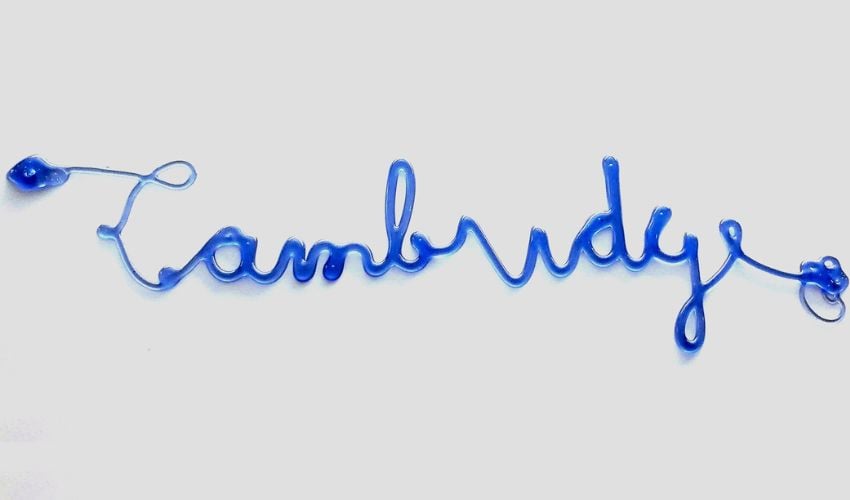Jackson Pollock Inspires Harvard 3D Printing Research

One of the most important American artists of the 20th century, Jackson Pollock has played a decisive role in shaping contemporary art. Known for his abstract expressionism, he was an artist who stood out because of his drip painting technique. Pollock’s signature paint drips may seem like random splashes of paint, but the technique is much more controlled than meets the eye. Pollock constantly controlled the flow of paint applied it to the canvas in measured amounts, and dripped colors onto the canvas in desired patterns with the help of gravity. Now, it has been used in a surprising field as inspired by Pollock’s approach to painting, scientists at Harvard University’s Soft Math Lab utilized the artist’s famous drip method while developing a new 3D printing technology.
In extrusion-based 3D printing, the nozzle must be only a few millimeters away from the build plate to control the stability of the material flow and prevent printing errors. Because of fluid dynamics, liquids that fall from a great height become more unstable as they fold or roll up into themselves. Pollock, on the other hand, seemed able to control this stream in his painting techniques. This prompted the Harvard research team to investigate whether 3D printing can use Jackson Pollock’s techniques to quickly and accurately print complex objects and shapes from a greater height.

Number 1 (Lavender Mist), 1950 by Jackson Pollock (Image credits: Wikimedia Commons)
“We wanted to develop a technique that could take advantage of the folding and coiling instabilities, rather than avoid them,” commented Gaurav Chaudhary, a member of the Harvard research group. To be able to apply Jackson Pollock’s liquid ‘rope trick’ to 3D printing, the research group benefited from the experience of the study’s leader, L. Mahadevan.
In his previous work, the Indian-American biologist and mathematician investigated the mathematical properties of objects and materials such as insect wings, fungal movement and liquid droplet formation. He was the one who provided an explanation over 20 years ago and attributed a reason to Pollock’s methods. The researchers thus combined the science of physics and AI programming to apply Pollock’s drip paint method to fast and precise 3D printing.
The aim of the research was not to create a new, AI-driven Jackson Pollock art using algorithms. Rather, the focus was on recreating the artist’s career-defining technique for use in additive manufacturing. The idea was that this could facilitate the fast and accurate 3D printing of complex shapes a greater distance away from the printing plate.
“If you look at traditional 3D printers, you supply them a path from point A to point B and the nozzle deposits ink along that specified path,” explains Chaudhary, “But Pollock’s approach of throwing paint from a height meant that even if his hand was moving in a specific trajectory, the paint didn’t follow that trajectory because of the acceleration gained from gravity. A small motion could result in a large splatter of paint. Using this technique, you can print larger lengths than you can move because you gain this free acceleration from gravity.”

Pollock experimented with fluid dynamics in his projects. With the help of artificial intelligence, a machine can learn to imitate this style. (Image credits: SEAS Harvard)
For successful printing, however, it is crucial to control dripping liquid from a greater distance through the nozzle of a 3D printer. To ‘teach’ the nozzle to do this, researchers relied on deep reinforcement machine learning. This is an algorithmic approach for iterative performance improvement. “With deep reinforcement learning, the model can learn from its mistakes and get more and more accurate with each trial,” says Chaudhary. Through this method, the nozzle repeatedly interacts with the environment with a viscous filament and improves its printing strategy based on the repeated results of the test.
A good visualization of this drip method is similar to how one puts icing on cookies. In fact, the researchers also decorated cookies with chocolate syrup and printed various complex shapes to test their method. Although only simple liquids were used in the study, the approach could be extended to liquid polymers, pastes and foodstuffs in the future and open up new horizons in 3D printing, according to the research team. “Harnessing physical processes for functional outcomes is both a hallmark of intelligent behavior, and at the heart of engineering design. This little example suggests, once again, that understanding the evolution of the first might help us be better at the second,” Mahadevan concluded. You can find out more about the Harvard project HERE.
What do you think about the Jackson Pollock-inspired 3D printing method under research at Harvard University? Let us know in a comment below or on our Linkedin, Facebook, and Twitter pages! Don’t forget to sign up for our free weekly Newsletter here, the latest 3D printing news straight to your inbox! You can also find all our videos on our YouTube channel.
*Cover photo credits: Soft Math Lab/Harvard SEAS







